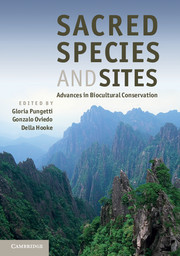Book contents
- Frontmatter
- Contents
- List of Contributors
- Foreword
- Preface
- Acknowledgements
- Introduction
- Part I Concepts and Knowledge
- Part II Sacred Landscapes
- Part III Sacred Sites and People
- Part IV Sacred Species
- Part V Sacred Animals
- Part VI Sacred Groves and Plants
- Part VII Implementation and Conclusions
- Index
- Plate Section
Foreword
Published online by Cambridge University Press: 05 August 2012
- Frontmatter
- Contents
- List of Contributors
- Foreword
- Preface
- Acknowledgements
- Introduction
- Part I Concepts and Knowledge
- Part II Sacred Landscapes
- Part III Sacred Sites and People
- Part IV Sacred Species
- Part V Sacred Animals
- Part VI Sacred Groves and Plants
- Part VII Implementation and Conclusions
- Index
- Plate Section
Summary
There is clear and growing evidence of strong links existing between cultural diversity and biodiversity, between sacred sites and a concentration of often unique species. There is in effect an intrinsic relationship between culture, religion, spirituality and the environment.
Sacred sites often provide sanctuaries for rare and endangered species, and contain important reservoirs of genetic and species diversity. They play an important role as a potential gene pool that can be used to restore degraded environments and can help protect ecosystems against other environmental threats.
In many societies, traditional sacred sites fulfil similar functions to protected areas. Due to the spiritual values attributed to these sites, restrictions on access and use often apply, and many such sites remain in a natural or near-natural condition. In sacred sites, human disturbance has usually been reduced or prevented, often for long periods of time, resulting in high levels of biodiversity. We can then say that sacred sites represent the oldest protected areas of the planet.
Because of their cultural and interdisciplinary character, sacred sites are also means for environmental education, cross-cultural learning and the intergenerational transmission of spiritual and biocultural knowledge. For example, at the Tibetan Phags Mo Gling Lamasary in China’s western Sichuan Province, lamas regularly survey the land by walking on paths lined with prayer flags and other offerings. They conduct trail maintenance and monitor bird diversity, floral health and soil composition, among other activities. The lamas have also developed a bird guide and regularly lead tourists on bird-watching treks on the sacred mountain.
- Type
- Chapter
- Information
- Sacred Species and SitesAdvances in Biocultural Conservation, pp. xvii - xxPublisher: Cambridge University PressPrint publication year: 2012
- 2
- Cited by



